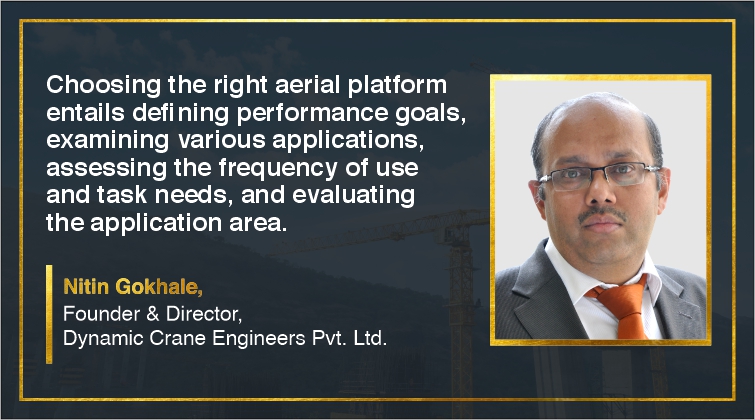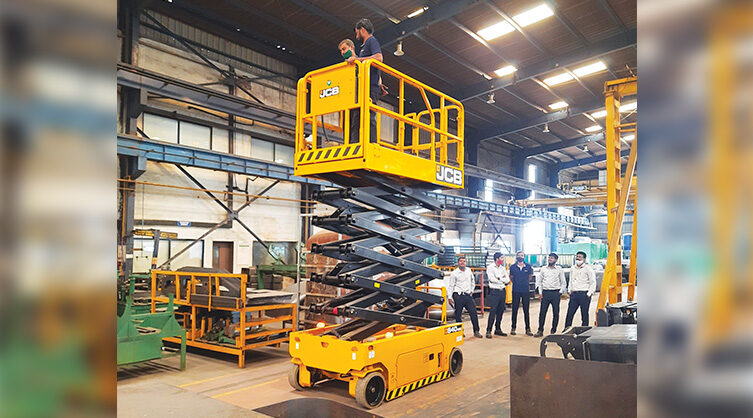Optimising access equipment evaluation for expertise and efficiency
By Edit Team | July 5, 2023 5:53 pm SHARE

Choosing the right aerial platform entails defining performance goals, examining various applications, assessing the frequency of use and task needs, and evaluating the application area.
Choosing the right aerial platform involves setting performance goals and considering various factors. Making informed decisions about purchasing aerial platforms, such as scissor lifts or boom lifts, requires careful consideration of performance goals and various factors. By understanding the end user’s ultimate objective and considering the diverse range of applications in our rental company, we can ensure the right choice.
Working height is another important consideration. Opting for a 60-foot machine when it can fulfil most tasks and renting an 80-foot machine only when necessary, can be prudent due to the significant price difference. Overspending on a giant machine that exceeds the requirements can have a negative impact on the company’s bottom line. Additionally, it is crucial to determine the type of access required. A scissor lift is appropriate for tasks below ground level while reaching higher areas requires an articulated boom lift. For extended outreach, a straight boom lift is an ideal solution.
For end users considering a purchase, assessing the necessity based on the frequency of use is essential. Investing in a machine becomes a worthwhile decision if the machine will be utilised for a significant portion of the year, such as 200 out of 365 days. Additionally, selecting the appropriate machine for the specific job and evaluating ground conditions are crucial. In greenfield projects, offline machines are ideal, while finished projects may require machines with solid or non-matching tires to accommodate any restrictions on diesel fumes.
A guide for access platform users and rental companies Assessing requirements for end users
End users must thoroughly analyse their requirements to make informed decisions when purchasing access platforms. This involves not only considering the technical skills necessary for operating the machine but also for its maintenance. Recognising the distinction between owning and maintaining a machine is vital. It is crucial to determine whether sufficient support is available from someone knowledgeable or the manufacturer. By carefully assessing these factors, end users can confidently decide whether investing in a machine is right. In some instances, where specialised or rare machines like spider booms are required, purchasing may be the most suitable option.
Considerations for rental companies
For rental companies, a different set of considerations comes into play. Understanding the target clientele and specific areas to serve is essential. Industries such as manufacturing may benefit from access platforms with booms of 16 or 18 meters, while steel or cement plants may require long-reach machines like 180-foot truck mounts with large booms. Additionally, careful evaluation of the geographic area to cover is crucial. Serving a vast region from a single location poses challenges, making it advisable to focus on specific states or regions. Furthermore, recognising the rising trend of shorter rentals is vital. Strategically positioning the company to cater to clients who require machines for shorter durations can lead to improved profit margins compared to long-term rentals.
Maintaining Competency with different machine brands
If a rental company decides to switch machine brands, it is imperative to possess the necessary core competencies to maintain the new equipment. While safety features may exhibit similarities across brands, each manufacturer may employ unique sensors and components, demanding specialised expertise. This ensures optimal performance and reliable operation of the machines. By investing in training and acquiring the requisite knowledge and skills, rental companies can effectively adapt to different machine brands and meet their maintenance requirements.

Exploring the significance of maintenance and machine lifespan in decision-making
Maintenance plays a critical role in the decision-making process for manufacturing companies. Proprietary sensors and specialised components are utilised to maintain the sales and service markets. Assessing your team’s capability to understand and procure these sensors is crucial. As an electronic engineer, I know extensively about these sensors and their availability challenges. Dependence on input parts becomes a significant criterion when selecting machines.
Considering the lifespan of machines is another key factor. Compared to aerial platforms, cranes have a longer life expectancy. This is due to cranes’ infrequent use and ability to handle heavy lifting. However, aerial platforms are durable and hardworking machines. Despite their robustness, their delicate nature results in a shorter active life than cranes. Rental companies must acknowledge that aerial platforms typically last up to 15 years.
When purchasing new machines, rental companies need to consider the preferences of clients who seek relatively new equipment. Technological advancements lead to rapid changes in battery technology and electronics, making it challenging to maintain older machines. Thus, rental companies must decide in advance whether to buy used or brand-new machines.
While acquiring brand-new machines is desirable, economic considerations often necessitate reliance on used machines within the rental industry. In such cases, it becomes essential to determine the preferred brands that align with your company’s familiarity and comfort. A diverse fleet of machines allows for the intelligent utilisation of spare parts. Evaluating these parameters is crucial when deciding which type of machine to purchase and how long to retain it, whether as a rental company or an end user looking to buy the machine.
Practices for machine procurement and maintenance
Regarding machine procurement, there are essential best practices to consider. Understanding the equipment’s lifespan is paramount, especially when purchasing used machines. Gathering information about the machine’s previous user and maintenance history is crucial. Although such machines may be slightly more expensive, knowing the spare parts used by the previous owner is invaluable. While reputable international traders offer reliable machines, it is important to refrain from traders involved in quick trades that may leave you with subpar equipment. Opting for a known source, preferably a multinational company, is a safer choice.
Another aspect to consider is knowing your team’s limitations. If your team lacks expertise in electronics, it is advisable to have someone with the necessary knowledge. Additionally, understanding your financial capacity is essential. Determine whether you can afford to purchase brand-new machines or if you will be relying on maintaining used machines. Ensuring you have an adequate supply of spare parts is crucial. Manufacturers like Haulotte, Genie, or JLG may need to provide a comprehensive list of recommended spare parts in the manual, so it is wise to stock up on necessary spare parts. This ensures you can provide excellent service to clients who rely on your machines for their projects.
Maintaining proper records of services and maintenance activities is highly recommended. Keep track of any parts replacements, engine overhauls, or other relevant maintenance tasks. This documentation not only facilitates better servicing but also enhances the machine’s resale value. Eventually, every machine will need to be resold or disposed of, and rental companies often opt to sell machines with remaining lives. Therefore, maintaining meticulous maintenance records is a beneficial practice. Consider using software systems or ERP systems to streamline this process. Alternatively, a simple pen-and-paper system can be employed where each mechanic responsible for maintenance records their work on the machine.
By following these best practices, you can make informed decisions regarding machine procurement and effectively maintain your equipment.
Training and skill development for effective machine operations and maintenance
In addition to machine procurement and maintenance practices, continuous training of your team is a critical aspect that should not be overlooked. With technology advancing rapidly, every machine becomes highly technical, necessitating ongoing training. Rental companies and users should actively seek manufacturer-provided beginner training for machine operations and comprehensive service and maintenance understanding. While agencies often offer training for basic operations (IPF), in-depth training for maintenance is essential and is usually provided by manufacturers. Investing in a well-trained team is crucial to imparting the necessary knowledge and skills.
Once you have a proficient and knowledgeable workforce, you can confidently manage your operations and stay ahead of the game. However, it is important to note that more than simply hiring mechanics may be required. Engineers should understand that having trained personnel operate the equipment is just the beginning. Specific skill sets may be required when adding new machines to your fleet. It is imperative to have team members with a detailed understanding of the machines, especially considering the many safety features and sensors involved. Malfunctioning sensors can jeopardise these safety features, rendering them ineffective when needed. Having a team member who comprehends the intricate details of the machines is invaluable, as it ensures the smooth functioning of both hardware and software components.
To summarise the best practices for rental companies, it is crucial to maintain an ample stock of spare parts, diligently keep records of maintenance activities, and prioritise investment in workforce and continuous training. By adhering to these practices, you can ensure your machines’ optimal performance and longevity, ultimately enhancing your operational efficiency and customer satisfaction.
(Excerpts of this article are taken from the individual submission of Mr. Nitin Gokhale of Dynamic Crane Engineers during the B2B Purchase procurement forum conducted in June 2023.)
Cookie Consent
We use cookies to personalize your experience. By continuing to visit this website you agree to our Terms & Conditions, Privacy Policy and Cookie Policy.




































-20240213125207.png)

























